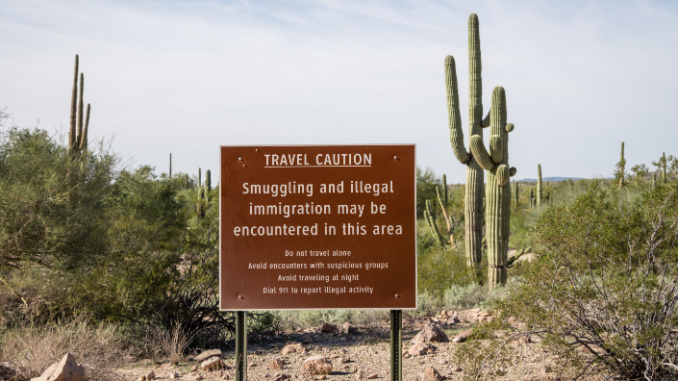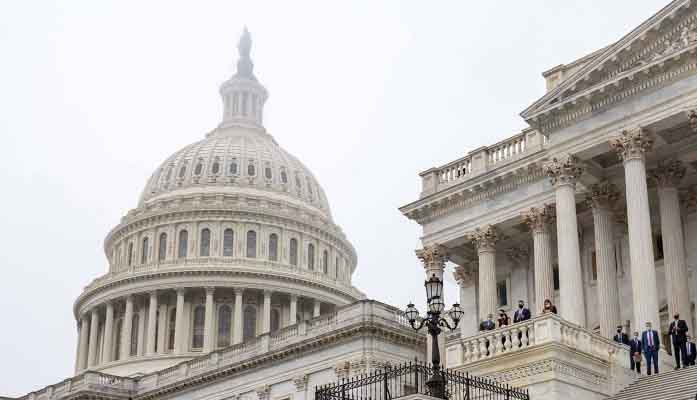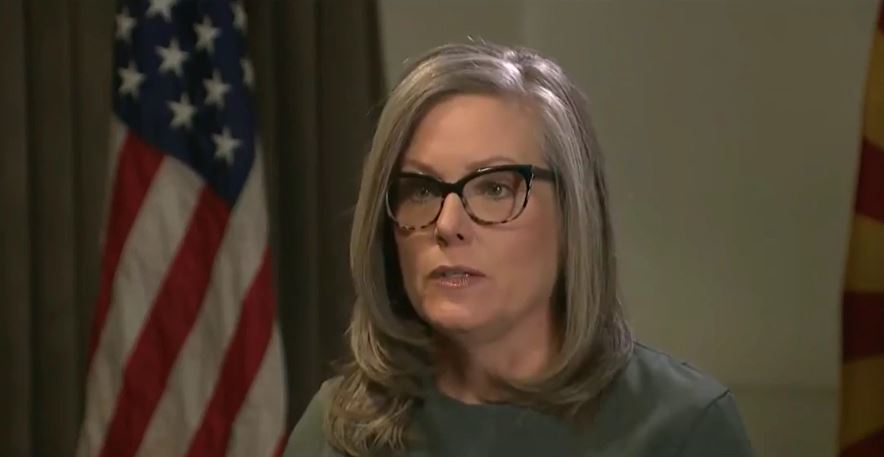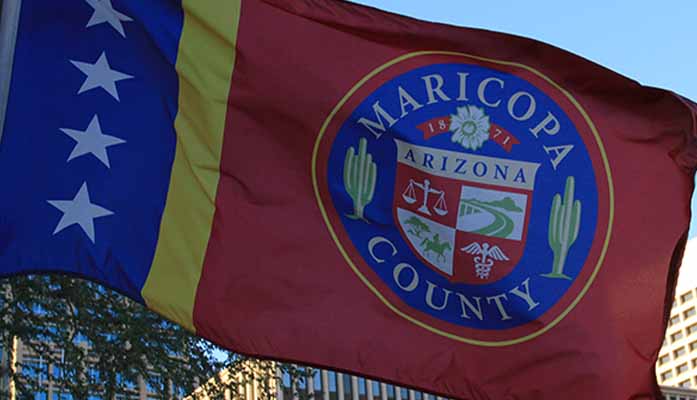
by Jonathan Eberle | May 25, 2025 | News
By Jonathan Eberle |
The U.S. Attorney’s Office for the District of Arizona announced Friday that 310 individuals were charged with immigration-related offenses between May 10 and May 16, as part of a weeklong federal enforcement initiative aimed at combating illegal immigration and associated criminal activity.
According to a press release from the U.S. Attorney’s Office, the charges include 125 cases involving illegal reentry into the United States and 170 cases of illegal entry. An additional 15 individuals were charged with human smuggling offenses, allegedly transporting undocumented immigrants into or within Arizona.
The enforcement actions were supported by a broad coalition of federal agencies, including U.S. Immigration and Customs Enforcement’s Enforcement and Removal Operations (ICE ERO), ICE Homeland Security Investigations (HSI), U.S. Border Patrol, the Drug Enforcement Administration (DEA), the Federal Bureau of Investigation (FBI), the U.S. Marshals Service (USMS), and the Bureau of Alcohol, Tobacco, Firearms and Explosives (ATF).
All charges were filed via criminal complaint. As noted in the release, a criminal complaint is a formal accusation and does not imply guilt; individuals charged are presumed innocent until proven guilty in court.
The cases fall under Operation Take Back America, a Department of Justice initiative described as targeting illegal immigration, cartel activity, and transnational crime. The operation coordinates federal resources, including those from the Department’s Organized Crime Drug Enforcement Task Forces (OCDETFs) and Project Safe Neighborhoods (PSN).
Officials have characterized the initiative as part of a broader strategy to “repel the invasion of illegal immigration” and dismantle transnational criminal organizations. The U.S. Attorney’s Office did not indicate how many of those charged remain in custody or when initial court appearances are scheduled. Further proceedings will be held in the U.S. District Court for the District of Arizona.
Jonathan Eberle is a reporter for AZ Free News. You can send him news tips using this link.

by Matthew Holloway | May 24, 2025 | Economy, News
By Matthew Holloway |
The ‘One, Big, Beautiful Bill’ was passed in a late-night round of voting in the U.S. House of Representatives on Wednesday with near-unanimous support from Republicans. The massive and wide-reaching budget reform bill now moves to the Senate
Two House Republicans, Reps. Thomas Massie (R-KY) and Warren Davidson (R-OH), opposed the measure. Rep. Andy Harris (R-MD) voted ‘Present’ and two Congressmen, Reps. Andrew Garbarino (R-NY) and David Schweikert of Arizona, reportedly missed the vote accidentally, but would have voted in favor.
Commenting on the result of the vote, Speaker Mike Johnson told reporters on Thursday morning, “I just want you to know for the record, we really had 217 votes this morning. Andrew Garbarino did not make it in time. He fell asleep in the back, no kidding. I’m going to strangle him. But he’s my dear friend.” He added, “David Schweikert was going to vote and slipped his card in right at the last minute so it looks like a razor thin margin, 215 to 214 and one present, it was really 217.”
The remaining members of the Arizona House Republican Caucus: Reps. Andy Biggs, Juan Ciscomani, Paul Gosar, Eli Crane, and Abe Hamadeh all voted in favor. Arizona Democrat Reps. Yassamin Ansari and Greg Stanton both joined their party opposing the measure.
Congressman Abe Hamadeh posted to X Thursday detailing the bill’s primary benefits, “Congressman Hamadeh proudly voted in favor of the One Big Beautiful Bill Act, keeping his promise to fully fund and advance President Trump’s incredible America First agenda. The bill:
• Delivers Permanent Tax Cuts
• Eliminates Taxes on Tips and Overtime
• Provides Tax Relief for Seniors
• Boosts Economic Growth and Wages
• Supports Small Businesses and Manufacturers
• Enhances Family and Education Benefits
• Promotes Border Security and Energy
• Reduces Federal Spending
And so much more.”
President Donald Trump celebrated the contentious bill through the House in a post to Truth Social writing,
“’THE ONE, BIG, BEAUTIFUL BILL’ has PASSED the House of Representatives! This is arguably the most significant piece of Legislation that will ever be signed in the History of our Country!
“The Bill includes MASSIVE Tax CUTS, No Tax on Tips, No Tax on Overtime, Tax Deductions when you purchase an American Made Vehicle, along with strong Border Security measures, Pay Raises for our ICE and Border Patrol Agents, Funding for the Golden Dome, ‘TRUMP Savings Accounts’ for newborn babies, and much more! “
The President offered praise for Speaker Mike Johnson (R-LA) and House Republican leaders saying, “Great job by Speaker Mike Johnson, and the House Leadership, and thank you to every Republican who voted YES on this Historic Bill! Now, it’s time for our friends in the United States Senate to get to work, and send this Bill to my desk AS SOON AS POSSIBLE! There is no time to waste.”
Trump concluded with an admonishment of Congressional Democrats saying, “The Democrats have lost control of themselves, and are aimlessly wandering around, showing no confidence, grit, or determination. They have forgotten their landslide loss in the Presidential Election, and are warped in the past, hoping someday to revive Open Borders for the World’s criminals to be able to pour into our Country, men to be able to play in women’s sports, and transgender for everybody. They don’t realize that these things, and so many more like them, will NEVER AGAIN happen!”
Looking forward toward the bill’s progress through the Senate, White House Press Secretary Karoline Leavitt said at Thursday morning’s press briefing, “We can celebrate this pass in the House for a couple of hours, but now it’s time for the Senate to get to work. The president has great relationship with … Senate Majority Leader [John] Thune, and of course, so many friends on the Senate side of the Hill. And he’s expecting them to get busy on this bill and send it to his desk as soon as possible.”
As reported by ABC News, Senate Majority Leader John Thune told reporters Wednesday that “there are things that we need to adjust or modify or change,” noting that Speaker Johnson “fully understands and accepts that.”
The bill may face serious challenges in the Senate where the current budget plan holds a trillion-dollar discrepancy with the House bill. Sen. Rand Paul explained, “[The] House bill is going to add about $4 trillion to the debt ceiling. The Senate bill adds $5 trillion. There’s nothing fiscally conservative about expanding the debt ceiling more than we’ve ever done it before. This will be the greatest increase in the debt ceiling ever, and the GOP owns this now … the deficit this year will be $2.2 trillion. The GOP owns that now too.”
Rep. David Schweikert was also skeptical about the Senate’s budget plan saying in an April 5th statement, “To say I’m disappointed with the Senate’s deeply unserious budget resolution would be an understatement. We are faced with an existential threat to both the short-term and long-term prosperity of America that requires a real solution, showing we are serious about slowing the growth of spending in the federal budget. With just $4 billion in cuts— equal to less than a single day’s worth of borrowing {about 20 hours}— the Senate budget resolution is more business as usual at a time when that’s exactly what we’re trying to avoid.”
Sen. Thom Tillis (R-NC) was more optimistic telling reporters, “A lot of it looks pretty good,” adding that the House bill is a “good start.”
Given the narrow majority in the Senate, Majority Leader Thune can only lose 3 votes to pass the bill.
Matthew Holloway is a senior reporter for AZ Free News. Follow him on X for his latest stories, or email tips to Matthew@azfreenews.com.

by Matthew Holloway | May 24, 2025 | News
By Matthew Holloway |
Democrat Rick McCartney, the founder of Phoenix-based advertising company InMedia, has become the fifth Democrat candidate to challenge incumbent Congressional District 1 Republican Rep. David Schweikert. McCartney, 58, joins fellow Democrats Amish Shah, Brian Del Vecchio, Marlene Galán-Woods, and Jonathan Treble in the upcoming Democratic primary to determine who will challenge the seven-term incumbent Republican budget hawk.
According to the Cook Political Report, Schweikert’s District is an R+1, classified in 2026 as a toss-up district despite the Republican’s 3.8 point victory in 2024 over Shah.
McCartney is an LGBTQ activist and has chaired the board of one-n-ten, “the largest organization supporting LGBTQ+ youth in Arizona,” according to his campaign website. In his bio he describes the campaign as “personal,” with his campaign stating, “As gay men, Rick and his husband stand in the crosshairs of Donald Trump’s assault on vulnerable communities.” He also chaired the Maricopa County Workforce Development Board, and is likely familiar to local Democrats.
But this was where the specifics from McCartney’s campaign ended. The site, appearing to be an early build, is bereft of policy planks or campaign goals other than to “stand up to Trump and end his lawless assault on vulnerable communities,” or claiming to know “what Arizona workers and businesses need to succeed,” and touting “lower prices, a growing economy, and jobs with good benefits.”
Speaking with AZCentral McCartney said, “What we’re seeing with Donald Trump right now is just very destructive to a lot of the great things that we’ve been working on here in this district.” As noted by the outlet, he is in quite deep with the Democrat powerbrokers of the state, joining elected officials on international trips with Governor Katie Hobbs and Phoenix Mayor Kate Gallego according to his LinkedIn.
Reporter Laura Gersony noted that McCartney also boasts “relationships with well-connected political donors and philanthropists.”
Matthew Holloway is a senior reporter for AZ Free News. Follow him on X for his latest stories, or email tips to Matthew@azfreenews.com.

by Jonathan Eberle | May 24, 2025 | News
By Jonathan Eberle |
On Thursday, Arizona State Representative Alexander Kolodin (R-LD3) accused Governor Katie Hobbs and Attorney General Kris Mayes of improperly delegating state powers to a Washington, D.C.-based advocacy organization. The accusation raises concerns about transparency and potential conflicts of interest in the administration of state business.
According to documents Kolodin says he obtained through a months-long investigation, both Hobbs and Mayes engaged in undisclosed agreements with the States United Democracy Center, a nonprofit organization focused on protecting elections and democratic norms. Kolodin alleged that the group holds connections to progressive donors and political agendas.
The materials released by Kolodin indicate that Hobbs, during her tenure as Secretary of State, contracted with States United on three separate occasions to provide assistance in managing her office. One such arrangement was reportedly renewed shortly after Hobbs assumed the governorship. Kolodin contends that while these services were presented as being provided at no cost to the state, States United simultaneously received permission to advocate in regulatory and legal proceedings against Arizona’s interests—even while advising top state officials.
The report also includes allegations that the group was allowed to delete public records, potentially in violation of state law. Kolodin claims that the organization’s acknowledgment of this risk was disregarded by AG Mayes, who publicly denied any wrongdoing. The Attorney General’s office, according to Kolodin, has yet to release additional documents tied to its interactions with States United.
“Governor Hobbs and Attorney General Mayes have betrayed Arizonans by allowing radical, dark-money activists to infiltrate and weaponize Arizona’s government,” said Kolodin in a statement. “This corrupt collusion must be exposed. The people deserve answers, transparency, and immediate accountability.”
The allegations are likely to intensify tensions in the state, where debates over election integrity and government transparency have remained prominent in recent years. Representative Kolodin, a Republican, serves in the Arizona House of Representatives and has been a vocal critic of Governor Hobbs’ agenda.
Jonathan Eberle is a reporter for AZ Free News. You can send him news tips using this link.

by Staff Reporter | May 23, 2025 | News
By Staff Reporter |
Maricopa County leaders are considering a $400,000 consulting contract to review and advise on elections.
The county is looking to contract with the accounting and consulting firm BerryDunn. The proposed contract would last for one year, with options to renew for up to four additional years. The contract also allows for the county to extend the contract on a monthly basis for up to six months after May 2026.
The Maricopa County Board of Supervisors was scheduled to decide on this contract during Wednesday’s meeting. They opted to delay a decision on the contract until their June 25 meeting.
BerryDunn has previously engaged in elections-related projects for the county. The firm conducted a procurement audit for the county’s voting system and related equipment in 2021, and an assessment of the county recorder’s election planning and Election Day activities following the 2018 primary and general elections.
Talks to secure a consulting firm for another audit of the county’s elections system emerged at the start of this year immediately after a slate of fresh faces took over the board of supervisors.
If approved, BerryDunn would review six areas of the county’s elections system with the goal of improving its efficiency: chain of custody, physical security, candidate filing compliance, temporary worker hiring and training, ballot drop boxes, and vote center selection and setup. In terms of efficiency, BerryDunn promised competency in assessing risk and analyzing trends while maintaining compliance with state and federal regulations.
The proposed timeline spans three phases promising 12 deliverables: planning and oversight for the first four weeks, discovery and fieldwork for the following 14 weeks, and reporting for the final seven weeks.
In its pitch to the county for the contract, BerryDunn pointed to the size of past clientele: 650 state, local, and quasi-governmental clients nationwide. Among those, BerryDunn completed election-related engagements for the New Hampshire secretary of state from 2020 to 2021 concerning its CARES Act elections assistance and grant management.
Within Maricopa County, BerryDunn has undertaken other non-elections projects over the last decade: the Adobe Dam Recreation Center Feasibility Study, Adult Probation Case Management Consultant, Adult Probation Department – Victim Services Review, Cyber Security Risk Assessment for the Judicial Branch, Housing Choice Voucher Forensic Audit Services for the Housing Authority, Information Security Program Maturity Assessment, Parks Fee Analysis, Regional County Parks Master Planning Services, and Sheriff’s Office Bonds, Fines, and Court Order Processing Audit.
Aside from Maricopa County, BerryDunn has contracted with many local and state entities within Arizona in the past: the Departments of Agriculture, Economic Security (and its Division Of Developmental Disabilities), and Health Services; the Arizona Health Care Cost Containment System; the State Land Department; Coconico, Maricopa, and Pima counties; the cities of Avondale, Glendale, Goodyear, Mesa, Phoenix, Scottsdale, Surprise, Tempe, and Tucson; and the towns of Gilbert, Prescott Valley, Queen Creek, and Sahuarita.
Several months ago, BerryDunn entered a $7.25 million class action lawsuit settlement over a 2023 data breach affecting over 1.1 million individuals. The data breach compromised the names, addresses, dates of birth, Social Security numbers, and health insurance policy numbers for the affected individuals.
AZ Free News is your #1 source for Arizona news and politics. You can send us news tips using this link.





